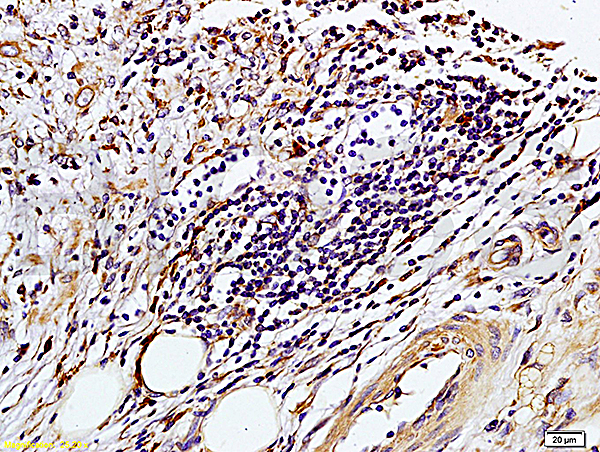
WB analysis of mouse lung tissue lysate using GTX64360 TIMP1 antibody. The signal was developed with ECL plus-Enhanced. Dilution : 1:3000 Loading : 25microg per lane
TIMP1 antibody
GTX64360
ApplicationsImmunoFluorescence, Western Blot, ImmunoCytoChemistry
Product group Antibodies
TargetTIMP1
Overview
- SupplierGeneTex
- Product NameTIMP1 antibody
- Delivery Days Customer9
- Application Supplier NoteWB: 1:500 - 1:2000. ICC/IF: 1:50 - 1:200. *Optimal dilutions/concentrations should be determined by the researcher.Not tested in other applications.
- ApplicationsImmunoFluorescence, Western Blot, ImmunoCytoChemistry
- CertificationResearch Use Only
- ClonalityPolyclonal
- ConjugateUnconjugated
- Gene ID7076
- Target nameTIMP1
- Target descriptionTIMP metallopeptidase inhibitor 1
- Target synonymsCLGI, EPA, EPO, HCI, TIMP, TIMP-1, metalloproteinase inhibitor 1, collagenase inhibitor, epididymis secretory sperm binding protein, erythroid potentiating activity, fibroblast collagenase inhibitor, tissue inhibitor of metalloproteinases 1
- HostRabbit
- IsotypeIgG
- Protein IDP01033
- Protein NameMetalloproteinase inhibitor 1
- Scientific DescriptionThis gene belongs to the TIMP gene family. The proteins encoded by this gene family are natural inhibitors of the matrix metalloproteinases (MMPs), a group of peptidases involved in degradation of the extracellular matrix. In addition to its inhibitory role against most of the known MMPs, the encoded protein is able to promote cell proliferation in a wide range of cell types, and may also have an anti-apoptotic function. Transcription of this gene is highly inducible in response to many cytokines and hormones. In addition, the expression from some but not all inactive X chromosomes suggests that this gene inactivation is polymorphic in human females. This gene is located within intron 6 of the synapsin I gene and is transcribed in the opposite direction. [provided by RefSeq, Jul 2008]
- Storage Instruction-20°C or -80°C,2°C to 8°C
- UNSPSC12352203








